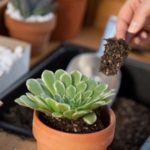Indoor potted plants are prone to leaf yellowing due to inadequate soil, overwatering, or nutrient deficiencies. Besides being unsightly and potentially leading to plant death, yellow leaves are also considered bad luck in Feng Shui. Try these tips to help your plants recover:
Soybean Water Treatment
Soybean water is a popular organic fertilizer for houseplants. Soybeans are rich in nutrients, and when soaked, they release a significant amount of nitrogen, providing a natural boost similar to nitrogen-based fertilizers. After soaking, the water becomes a potent tonic for your plants. If your plants are suffering from nutrient deficiencies or limited soil, try giving them a drink of soybean water.

Soybeans Provide a Nutritional Boost for Plant Growth
Preparing soybean water is simple: Soak soybeans in water and expose them to sunlight to accelerate fermentation. After 20-30 days, the solution is ready for use. However, it’s important to dilute the soybean water before application; undiluted soybean water can harm your plants. Apply this solution every 10 days, and after 2-3 applications, you’ll notice significant improvements in your plant’s health. During winter, when plants enter their dormant phase, soybean water helps maintain their vitality and promotes new leaf growth.
Aspirin Treatment for Root Health
Aspirin, commonly used for pain relief and fever reduction in humans, is also beneficial for plants. The active ingredient in aspirin, salicylic acid, helps regulate soil pH, supporting root development and preventing root rot, which can lead to leaf yellowing. Even expired aspirin tablets can be used for this purpose.
To prepare an aspirin solution, crush a tablet and dilute it in one liter of water. The recommended ratio is one tablet per liter of water.

Aspirin Helps Strengthen Plant Roots
Fruit Peel Water
Fruit peels, such as banana and apple peels, are rich in nutrients and beneficial for plants. You can ferment or chop these peels and place them at the base of your plants to allow for gradual decomposition.
Here’s how: Cut fruit peels into small pieces, add water, and expose them to sunlight to accelerate fermentation. Adding a small amount of sugar will further expedite the process. Dilute the fermented solution and water your plants with it during their growth phase. Remember to pour the solution near the roots, avoiding the leaves. Always dilute fermented solutions before application.
- Overwatering: Check if the soil is consistently wet, leading to waterlogging and potential root rot.
- Pest or disease infestation: Look for black spots or signs of pests/diseases on the leaves and stems.
- Lack of sunlight: Ensure your plants are receiving adequate natural light.
- Nutrient deficiency: If you haven’t been providing plant food or fertilizer, leaves may turn yellow, thin, and wilt.
3 Things to Avoid When Growing Money Trees to Keep Them Lush and Lucky
Introducing the three golden rules to ensure your money tree thrives and brings prosperity to your home. First, let’s uncover the secrets to maintaining lush, vibrant leaves and a healthy plant all year round. But, most importantly, we’ll explore how this humble plant can become a powerful magnet for wealth and good fortune.






































